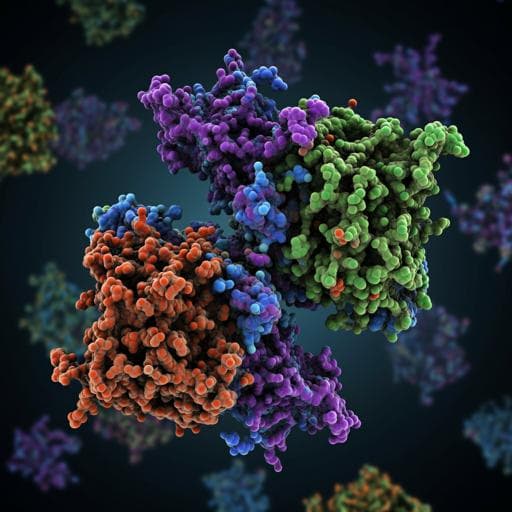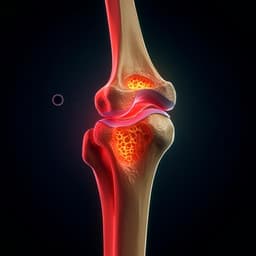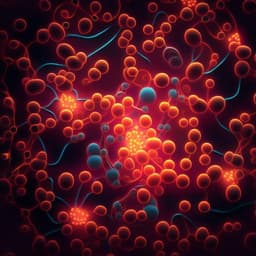
Mathematics
Quantifying in vitro B. anthracis growth and PA production and decay: a mathematical modelling approach
B. Williams, J. Paterson, et al.
This study by Bevelynn Williams and colleagues delves into the dynamics of protective antigen production and degradation by Bacillus anthracis, employing mathematical modeling and Bayesian techniques to shed light on toxin dynamics and implications for anthrax infection management.
~3 min • Beginner • English
Introduction
The study addresses how Bacillus anthracis produces and degrades protective antigen (PA), the essential component of anthrax toxin required for EF and LF entry into host cells and the principal antigen in licensed vaccines. While mechanistic within-host models exist for other pathogens and a qualitative toxin component was included in prior anthrax modelling, quantitative in vitro data for PA dynamics have been limited. The purpose here is to generate new measurements of PA in culture supernatants of the B. anthracis Sterne strain and to develop and calibrate a mechanistic, delay differential equation model that captures spore germination, bacterial growth, PA production, and PA decay (natural and protease-mediated). By integrating three independent in vitro datasets (a new Dstl dataset plus published datasets by Zai et al. and Charlton et al.), the study aims to estimate biologically interpretable parameters and provide a quantitative foundation for future within-host anthrax models and evaluation of anti-PA therapies.
Literature Review
Prior experimental work quantified toxin proteins from B. anthracis in vitro. Zai et al. measured PA and LF expression in A16R and Sterne strains, reporting sigmoidal bacterial growth to ~10^10 CFU/ml, PA/LF peaking at ~12–16 h, then rapidly declining—potentially due to glucose depletion or protease-mediated cleavage (e.g., InhA1). Addition of protease inhibitors prevented the post-peak decline, supporting a protease contribution. Charlton et al. simulated AVP vaccine manufacturing with Sterne 34F2, observing much higher PA/LF levels, no marked toxin breakdown after peak, and apparent metabolic shifts after glucose exhaustion. Methodological differences (media, agitation vs static incubation, heat activation of spores) likely explain discrepancies. On the modelling side, multi-scale frameworks for other pathogens (e.g., Francisella tularensis) have been parameterised from diverse data sources, and an earlier anthrax model included toxins qualitatively without units. These prior findings motivate a more mechanistic, quantitative model of PA production and decay aligned with experimental conditions.
Methodology
Experimental data: Three datasets were used. (1) New Dstl dataset: Sterne 34F2 spores inoculated into BHI broth with added sodium bicarbonate (48 mM) and CO2; shaking at 37 °C. Time-course sampling captured spore counts, viable (vegetative) counts, and PA concentrations quantified via Jess Simple Western; initial conditions measured within minutes post-inoculation enabled setting S(0), B(0). Heat activation was not performed, leading to slower germination. (2) Zai et al.: A16R and Sterne strains grown in LB with agitation; PA quantified by ELISA; an additional A16R experiment included protease inhibitors to isolate natural PA decay. Initial model bacterial counts were inferred from the 4 h measurement under exponential growth back-calculation. (3) Charlton et al.: Sterne 34F2 in basal medium, static incubation; spores heat-activated prior to inoculation; serial sacrifice of bottles up to 32 h; PA by antigen-capture ELISA. Initial bacterial counts were inferred from early timepoints.
Mathematical model: A deterministic system of delay differential equations tracks germinating spores S(t), newly desporulated bacteria N(t), vegetative bacterial CFU V(t) with logistic growth (rate λ, carrying capacity K), nutrient level G(t) (normalised to 1 at t=0, consumed proportionally to V at rate α), and PA concentration P(t). Spores germinate at rate g into N, which mature into V at rate m. Vegetative bacteria produce PA at maximal per-CFU rate β scaled by nutrient level G(t). PA decays via two mechanisms: natural decay at rate parameter (treated as intrinsic to PA, denoted v0/γ) and protease-mediated degradation proportional to past vegetative biomass V(t−τ2) with delay τ2; PA production experiences a delay τ1. Proteases are not explicitly modelled as a variable. The only steady state is (S,N,V,G,P)=(0,0,K,0,0).
Calibration and inference: Parameters with uniform (some log-uniform) priors (f,g,ε,m,λ,K,α,β,γ/natural decay, δ/protease-mediated decay, τ1, τ2) were inferred via approximate Bayesian computation sequential Monte Carlo (ABC-SMC) using decreasing distance thresholds. Model outputs were compared to data via two distances: D1 combining log10-scale errors for total bacteria and (for Dstl) spores, and D2 the absolute error for PA; Gaussian noise matched experimental variability was added to simulated points. Where available (Zai A16R with protease inhibitors), a parallel PA equation with zero protease-mediated decay was fit to estimate natural decay. The natural decay rate estimated from A16R with protease inhibitors was then fixed across other datasets to leverage identifiability. Initial conditions were set from measured or inferred early-time CFU and spore counts specific to each dataset. Posterior summaries and predictive credible intervals were generated to assess fit and compare datasets.
Key Findings
- A single DDE model reproduced in vitro dynamics of bacterial growth and PA production/decay across three independent datasets (Zai A16R and Sterne; Charlton Sterne; new Dstl Sterne) under dataset-specific assumptions.
- Natural PA decay versus protease-mediated decay could be distinguished by leveraging the Zai A16R protease-inhibitor experiment to fix the natural decay rate for other datasets.
- Two plausible parameter regimes explain late-time PA decline when protease-inhibitor data are absent: (i) nutrient depletion dominates (PA production stops; PA then decays), or (ii) continued PA production but stronger protease-mediated degradation. Cross-dataset consistency and inhibitor results favour nutrient depletion as the main mechanism for rapid PA decline at late times.
- Bacterial growth parameters were broadly consistent across Zai and Charlton datasets; Dstl showed faster growth and higher carrying capacity, likely due to richer medium (BHI with bicarbonate/CO2): λ roughly 0.5–0.97 h⁻¹ across datasets; K on the order of 6×10^7–1×10^8 CFU/ml (Dstl higher).
- PA production and nutrient-use parameters: Charlton data suggested higher maximal per-CFU PA production rate β and faster nutrient consumption α, potentially due to static incubation and oxygenation differences; Zai and Dstl estimates were more similar. Median β typically on the order of 0.2–0.4 ng·(CFU·h)⁻¹; α around 10⁻¹⁰ (CFU·h)⁻¹.
- Delays: Protease-production delay τ2 was consistently estimated between ~10 and 25 h across datasets; PA-production delay τ1 varied with experimental setup, appearing longer when spores were directly inoculated (e.g., Dstl) versus when pre-grown cultures were used (Zai).
- Dstl-specific estimates enabled calibration of spore germination dynamics: fraction of spores able to germinate f ≈ 1; germination rate g consistent in order of magnitude with previous estimates; slower germination observed without heat activation allowed identification of additional parameters.
- Model predictions under protease inhibition: For datasets with evidence of nutrient depletion, inhibiting proteases yields PA plateauing rather than decline; when nutrient depletion is slow, the model predicts much higher PA if proteases are inhibited.
Discussion
The model clarifies the relative roles of nutrient availability and protease-mediated degradation in shaping PA dynamics. By fixing the natural PA decay rate from a protease-inhibitor experiment, the framework isolates protease effects elsewhere and shows that late-time PA declines are best explained, in most cases, by nutrient depletion halting PA production. Differences in growth and PA production across datasets are consistent with experimental conditions: richer media (Dstl) support faster growth and higher K; static incubation (Charlton) may elevate PA production rates. Strain differences (Sterne vs A16R) were present but not larger than inter-laboratory differences, suggesting experimental context is as influential as strain for growth and PA output. The model’s capacity to fit multiple datasets with a common structure supports its utility for downstream within-host modelling. However, identifiability trade-offs exist among nutrient consumption (α), PA production (β), and production delay (τ1), and explicit protease dynamics could not be resolved without direct protease measurements. Overall, the analysis provides a quantitative basis for incorporating PA kinetics and anti-PA interventions into mechanistic anthrax models.
Conclusion
This work introduces and calibrates a unified DDE model for B. anthracis spore germination, vegetative growth, nutrient use, PA production, and PA decay, using three independent in vitro datasets including a new Dstl dataset. It quantitatively separates natural PA decay from protease-mediated degradation and identifies two plausible mechanisms for late-time PA decline, with evidence favouring nutrient depletion as the dominant driver in most settings. The parameter estimates and modelling framework offer a foundation for future within-host anthrax models that incorporate toxin dynamics and anti-PA therapies. Future directions include: collecting protease concentration data to explicitly model protease dynamics; measuring specific nutrients to refine and unify interpretation of PA production parameters across studies; exploring non-linear relationships between nutrient level and PA expression; and extending the framework to EF/LF and in vivo conditions, coupled with PK/PD descriptions of anti-toxin treatments.
Limitations
- Lack of direct protease measurements prevents explicit modelling of protease dynamics; protease effects are inferred indirectly via delays and proportional terms, leading to identifiability issues with nutrient depletion and PA production parameters.
- Nutrient level is modelled as a normalised proxy without measured concentrations; the assumption of proportionality between G(t) and per-CFU PA production may oversimplify a potentially non-linear relationship.
- Some datasets lack protease-inhibitor controls, limiting discrimination between nutrient-depletion and protease-driven PA decline; multiple parameter regimes can fit observed PA decay.
- Initial conditions for some datasets were inferred from later timepoints, which can propagate uncertainty.
- Only PA is modelled among the toxin components; EF and LF dynamics and interactions are not included.
- In vitro findings may not directly translate in vivo, where host proteases and immune responses affect PA degradation.
- Parameter correlations (e.g., among α, β, τ1) indicate partial non-identifiability given available data and measurements.
Related Publications
Explore these studies to deepen your understanding of the subject.







